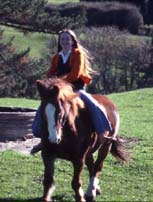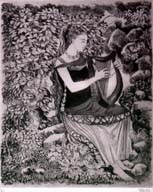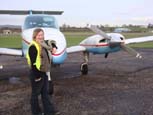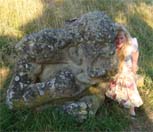 |
|||||||||||
|
|
|||||||||||
 |
|||||||||||
|
Aged 18 on “Chance” |
|||||||||||
 |
|||||||||||
|
”Carolan’s Muse” - etching |
|||||||||||
 |
|||||||||||
|
With a Beechcraft Duchess |
|||||||||||
 |
|||||||||||
|
With a Maori carving on Mount Victoria, Devonport, New Zealand |
|||||||||||
|
Elizabeth Barton - Biography |
|
From a very young age I could draw, and I loved to draw. Living on a farm in New Zealand, among the first subjects I ever drew were horses. I loved to draw, and I loved to draw horses, and ride them. I was taught by my father to ride at the age of four, and when I was bucked off on my first ride, I laughed. My father picked me up and put me back on the horse, a fat piebald called Tammy. Riding wasn’t about stepping out with saddles and bridles. We rode bareback, with a simple bridle or halter. We went out on moonlit nights, riding all over the farm, and neighbouring farms, getting lost in the bush in the dark, and coming back before our parents wondered where we had got to. Riding was an essential part of life on the farm, and in my teens I was hired by neighbouring farmers to muster large sheep herds. For my labours I was bought a collection of classical records, and so my love of classical music was born. Horses became interwoven into the myth of my personal creativity, with hours spent riding all over the Peria Hills and Richmond, remote rural areas in the heart of the Waikato. The hills and volcanic mountains beyond provided the right trigger for vigorous thunderstorms, and nothing was quite as exciting as going out for a long ride, watching a big storm brew out over the hills, then galloping back home ahead of it. My mother was intrigued by a drawing I had made at three or four, of indigenous women in grass skirts and naked breasts, which drooped low. I had never seen any such figures in life. A subconscious memory, perhaps? But from where? She also told me my drawings were displayed in a little exhibition at our primary school. I don’t remember much about that, but I do remember doing small ink drawings of horses and foals as greetings cards when I was eight, and these were sold. In my teens, a neighbour took some of my drawings with her to London, which ended up being viewed by the curator of the RoyalAcademy. The outcome was that I could study there, but I needed to find the funding to study and live abroad. Finding the money was an interesting expedition in its own right. In 1979, I applied for some assistance from a local branch of Rotary, thinking it might help the arts in New Zealand. Imagine me, with a group of men sitting all around interviewing me. After some discussion, one of them said to me, “But Miss Barton, you’ll have a husband to support you”. “A what?” I interjected. That remains in my mind one of the most absurd propositions ever. Here was some person with his head in some fictional and unlikely future scenario. I was aiming to travel to London to study, and then make a career as an artist, and I was requesting a financial kick-start. What had marriage or husbands to do with it? A lot of people thought like that in those days, and a lot more besides which I found completely absurd. That is part of the Gnostic demon that Terence McKenna refers to as modern culture. Taking a more circuitous route, I graduated from Otago Polytechnic School of Fine Art in 1982, majoring in printmaking. Having not studied in London was not a real loss. The school in Dunedin was the oldest in New Zealand, as a recent graduate described, ‘the most happening place’. In my final year, a group of three of us, Kevin, Richard and me, used to work in the printmaking studios all through the night like industrious gnomes, such was our passion for printmaking. Since I was the smallest, and nimble, I used to shimmy up a drain pipe to a first floor window, crawl in, and the let the others in through the door. In the mornings, the tutor would come in to see our work festooned all around hanging up to dry. All through my teens I had work on show in various galleries, and sold quite a few works through commissions. In 1984, I held a solo show at the Moray Gallery in Dunedin, which enabled me to travel to London, at last! Had I decided to stay, I was offered a printmaking tutor position, and if I had accepted it, I would have been the first woman at that time to teach at the school. That is not a grand landmark, but someone at the time did describe the school as being the last bastion of male chauvinism. Fortunately, it is far from being now. Coming to London was a landmark in my life. I didn’t know a soul, but I found my feet, especially after coming into contact with what I lovingly call ’The London Posse’. I was introduced to a group of friends by a pilot, Phil Croucher, and we’ve remained friends ever since. This is where Fate and Destiny threaten to part company, when one becomes overwhelmed by the stimulus of a big city, and faced with challenges of making ends meet, and keeping the flame lit through it all. I got into illustration, and working for various architectural and engineering companies. Most of my work came from publishing, illustrating books. My only regret is that I did not more vigorously pursue my fine art adventures, for that is what creating is. I could have built on a successful show in the West End held by The Association of Illustrators, entitled Shop Window. Upcoming talent was showcased, and artists were invited to show their work. I was put forward by an art director, Fig Taylor, who bought one of my drawings in the show. She was also a champion of my work in the face of opposition of certain art directors, who claimed there were too many nymphs in my art, and that it was ‘dated’. “Yes! But it’s dated by 150 years!” she joyously proclaimed. My reaction to the opposition was simply, who cares? You are always going to have champions and detractors. But it’s important to have champions who are more powerful. After being involved in freelance commercial art for a number of years, a completely different calling took me on a new journey, and I learned to fly. In 1997 I gained a Private pilots Licence, in 2000, a Commercial Pilots Licence, and in 2001, won a GAPAN (Guild of Air Pilots and Air Navigators) Scholarship for a Flight Instructor Rating. The people who interviewed me for the Scholarship challenged me with fascinating questions about my vision and philosophy toward flying, apart from technical and safety related questions, and not one of them made any absurd propositions or dreamed up fictitious scenarios. Had I conquered the Gnostic demon through flying? I have more than 4000 flying hours, I have flown professionally from spring 2002, and the show goes on. In the background, the creative fires still simmered. In fact, studying for the Commercial Pilot exams meant I had to suppress my creativity with certain force. Since the purpose was to become a professional pilot, it was acceptable. But after a time, a new voice – or, a very old voice – was calling me back to my art. As so much inspirational material comes from dreams, and the contemplation of dreams, the calling to art came after a dream earlier this year, and instigated a tsunami of creativity that has not diminished since. So here it is the beginning of an exciting and mysterious journey into Art that I do not know where it will lead me. On this website you will see drawings, old and new, paintings in pastel, pastel-pencil or artists’ coloured pencils such as Faber-Castell Polychromos, paintings in watercolour and oil, and my favourite medium, etching. All of the studies are from life. I do not use photographs. Life drawing is another aspect of the passion I have for art, and helps to build what Henry Moore called form knowledge. Before attending art school, I spent hours drawing, studying from nature, which entailed explorations many miles from home in the wilds, and studying Old Masters. I learned to draw from memory. For years I wanted to get back into printmaking, and recently I was able to indulge my wish by attending a workshop at the East London Printmakers, of which I’m now a member. |
| [Home] [Gallery Foyer] [Biography] [Events] [Links] [Contact] [Blog] |